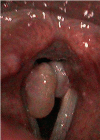Diagnostic and therapeutic pitfalls in benign vocal fold diseases
- PMID: 24403969
- PMCID: PMC3884536
- DOI: 10.3205/cto000093
Diagnostic and therapeutic pitfalls in benign vocal fold diseases
Abstract
More than half of patients presenting with hoarseness show benign vocal fold changes. The clinician should be familiar with the anatomy, physiology and functional aspects of voice disorders and also the modern diagnostic and therapeutic possibilities in order to ensure an optimal and patient specific management. This review article focuses on the diagnostic and therapeutic limitations and difficulties of treatment of benign vocal fold tumors, the management and prevention of scarred vocal folds and the issue of unilateral vocal fold paresis.
Keywords: benign vocal fold lesions; evaluation of voice; phonosurgery; unilateral vocal fold paralysis; vocal fold scarring; voice disorder; voice therapy.
Figures













Similar articles
-
[Diagnostic and therapeutic pitfalls in benign vocal fold diseases].Laryngorhinootologie. 2013 Apr;92 Suppl 1:S239-57. doi: 10.1055/s-0032-1333304. Epub 2013 Apr 26. Laryngorhinootologie. 2013. PMID: 23625715 Review. German.
-
[Phonosurgery of chronic vocal cord edema].Srp Arh Celok Lek. 1997 Nov-Dec;125(11-12):349-52. Srp Arh Celok Lek. 1997. PMID: 9480569 Serbian.
-
Injection laryngoplasty as miniinvasive office-based surgery in patients with unilateral vocal fold paralysis - voice quality outcomes.Wideochir Inne Tech Maloinwazyjne. 2017 Sep;12(3):277-284. doi: 10.5114/wiitm.2017.68868. Epub 2017 Jul 17. Wideochir Inne Tech Maloinwazyjne. 2017. PMID: 29062449 Free PMC article.
-
Is voice therapy effective for the treatment of dysphonic patients with benign vocal fold lesions?Auris Nasus Larynx. 2018 Aug;45(4):661-666. doi: 10.1016/j.anl.2017.08.003. Epub 2017 Aug 31. Auris Nasus Larynx. 2018. PMID: 28844607 Review.
-
Subjective and Objective Analyses of Voice Improvement After Phonosurgery in Professional Voice Users.Med Probl Perform Art. 2016 Mar;31(1):18-24. doi: 10.21091/mppa.2016.1004. Med Probl Perform Art. 2016. PMID: 26966960
Cited by
-
A machine learning approach for vocal fold segmentation and disorder classification based on ensemble method.Sci Rep. 2024 Jun 23;14(1):14435. doi: 10.1038/s41598-024-64987-5. Sci Rep. 2024. PMID: 38910146 Free PMC article.
-
The Utility of Stroboscopy in Evaluating Patients with Benign Vocal Fold Lesions.Maedica (Bucur). 2023 Sep;18(3):504-509. doi: 10.26574/maedica.2023.18.3.504. Maedica (Bucur). 2023. PMID: 38023751 Free PMC article.
-
Validation and Evaluation of the Effects of Semi-Occluded Face Mask Straw Phonation Therapy Methods on Aerodynamic Parameters in Comparison to Traditional Methods.J Voice. 2017 May;31(3):323-328. doi: 10.1016/j.jvoice.2016.04.009. Epub 2016 May 19. J Voice. 2017. PMID: 27210476 Free PMC article.
-
Efficacy of microsurgery in Reinke's oedema evaluated by traditional voice assessment integrated with the Vocal Extent Measure (VEM).Acta Otorhinolaryngol Ital. 2018 Jun;38(3):194-203. doi: 10.14639/0392-100X-1544. Acta Otorhinolaryngol Ital. 2018. PMID: 29984795 Free PMC article.
-
[Office-based phonosurgery].HNO. 2021 Sep;69(9):719-725. doi: 10.1007/s00106-021-01081-6. Epub 2021 Jun 30. HNO. 2021. PMID: 34195859 Free PMC article. Review. German.
References
-
- Zeitels SM, Healy GB. Laryngology and phonosurgery. N Engl J Med. 2003 Aug;349(9):882–892. doi: 10.1056/NEJMra035148. Available from: http://dx.doi.org/10.1056/NEJMra035148. - DOI - DOI - PubMed
-
- Cohen SM, Kim J, Roy N, Asche C, Courey M. The impact of laryngeal disorders on work-related dysfunction. Laryngoscope. 2012 Jul;122(7):1589–1594. doi: 10.1002/lary.23197. Available from: http://dx.doi.org/10.1002/lary.23197. - DOI - DOI - PubMed
-
- Altman KW. Vocal fold masses. Otolaryngol Clin North Am. 2007 Oct;40(5):1091–108, viii. doi: 10.1016/j.otc.2007.05.011. Available from: http://dx.doi.org/10.1016/j.otc.2007.05.011. - DOI - DOI - PubMed
-
- Sataloff RT. G. Paul Moore Lecture. Rational thought: the impact of voice science upon voice care. J Voice. 1995 Sep;9(3):215–234. - PubMed
-
- Johns MM. Update on the etiology, diagnosis, and treatment of vocal fold nodules, polyps, and cysts. Curr Opin Otolaryngol Head Neck Surg. 2003 Dec;11(6):456–461. - PubMed
Publication types
LinkOut - more resources
Full Text Sources

